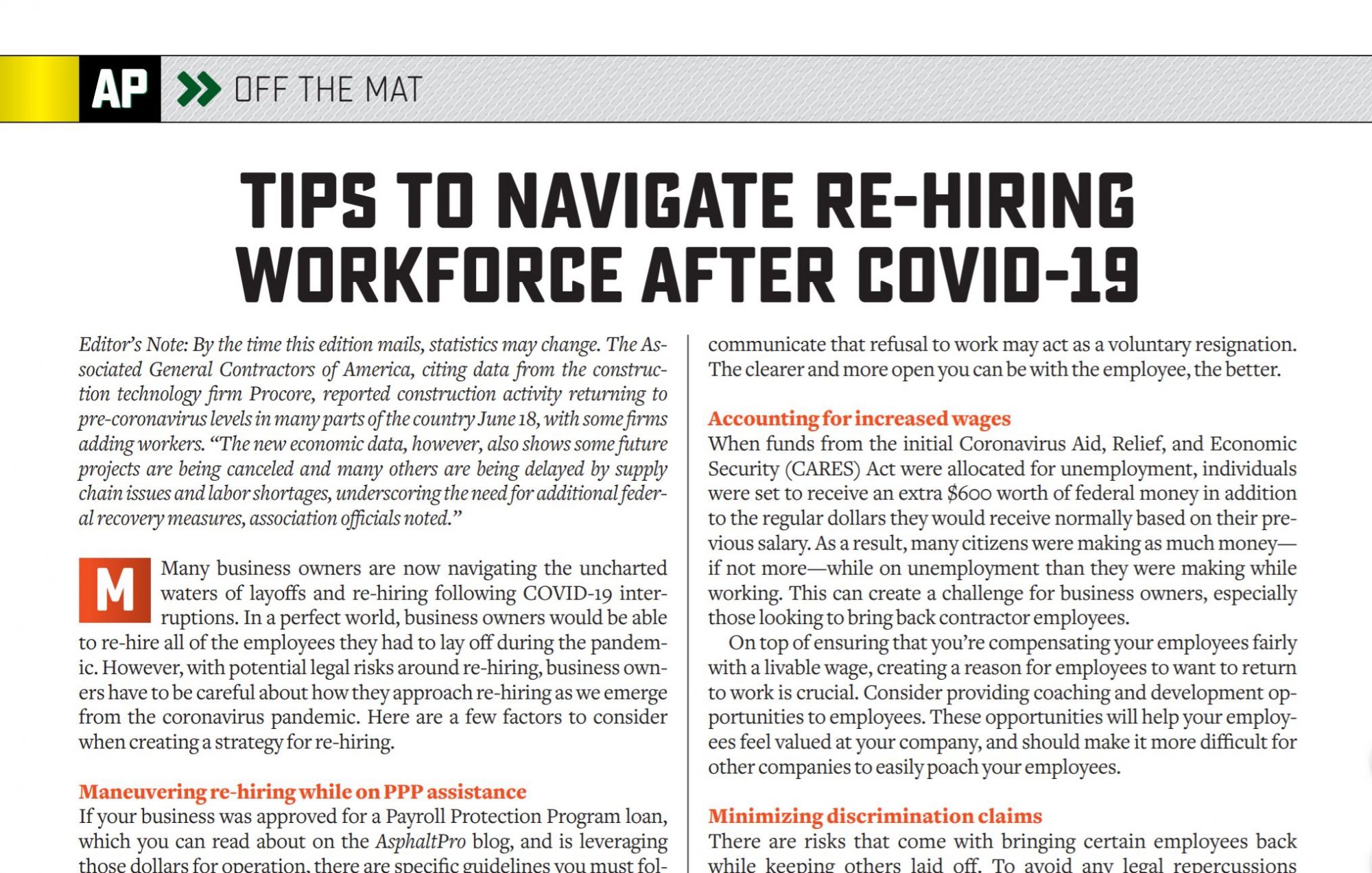Tips to Navigate Re-hiring Workforce After COVID-19
BY Bob Lester

Editor’s Note: By the time this edition mails, statistics may change. The Associated General Contractors of America, citing data from the construction technology firm Procore, reported construction activity returning to pre-coronavirus levels in many parts of the country June 18, with some firms adding workers. “The new economic data, however, also shows some future projects are being canceled and many others are being delayed by supply chain issues and labor shortages, underscoring the need for additional federal recovery measures, association officials noted.”
Many business owners are now navigating the uncharted waters of layoffs and re-hiring following COVID-19 interruptions. In a perfect world, business owners would be able to re-hire all of the employees they had to lay off during the pandemic. However, with potential legal risks around re-hiring, business owners have to be careful about how they approach re-hiring as we emerge from the coronavirus pandemic. Here are a few factors to consider when creating a strategy for re-hiring.
Maneuvering re-hiring while on PPP assistance
If your business was approved for a Payroll Protection Program loan, which you can read about on the AsphaltPro blog, and is leveraging those dollars for operation, there are specific guidelines you must follow on how many employees you’re bringing back to qualify for loan forgiveness.
Following the recent PPP changes, the loan can be forgiven up to 100 percent if a borrower spends 60 percent of their loan on payroll. This new number is more flexible than the initial 75 percent that was required initially.
Navigating fear to return to work
Many employees may be scared to return to work in the current climate for health and safety reasons. If you find yourself offering to re-hire an employee, but he or she voices concern about returning, facilitating an open and honest conversation with the employee goes a long way.
Some employees may have immunocompromised family members at home or may be at a greater health risk themselves. Making sure to lead with empathy is of greatest importance, especially as we emerge from a pandemic. As an employer, you have an obligation to provide a safe workplace. Part of making sure your employees feel safe returning involves clearly communicating how sanitization and other safety protocols, including social distancing and protective equipment use, will be handled. You should also provide specifics, like how often surfaces, machinery, and shared spaces will be cleaned and who will be responsible for these processes. A good rule of thumb is to ensure your company is complying with the Centers for Disease Control and Prevention recommendations for our industry, then take a step back and ask yourself if you’d feel comfortable in your employees’ shoes.
If employees still feel unsafe after a candid conversation and clearly communicated, adjusted safety protocols, consider whether their reasoning falls under paid sick leave or other laws that require disability accommodation. If neither of these fit the circumstance and you feel that, as a business owner, you cannot hold their job, you must clearly communicate that refusal to work may act as a voluntary resignation. The clearer and more open you can be with the employee, the better.
Accounting for increased wages
When funds from the initial Coronavirus Aid, Relief, and Economic Security (CARES) Act were allocated for unemployment, individuals were set to receive an extra $600 worth of federal money in addition to the regular dollars they would receive normally based on their previous salary. As a result, many citizens were making as much money—if not more—while on unemployment than they were making while working. This can create a challenge for business owners, especially those looking to bring back contractor employees.
On top of ensuring that you’re compensating your employees fairly with a livable wage, creating a reason for employees to want to return to work is crucial. Consider providing coaching and development opportunities to employees. These opportunities will help your employees feel valued at your company, and should make it more difficult for other companies to easily poach your employees.
Minimizing discrimination claims
There are risks that come with bringing certain employees back while keeping others laid off. To avoid any legal repercussions around discrimination, business leaders should be thoughtful about which employees they are bringing back if they are not bringing back all employees.
Consider factors such as seniority, operational needs or past performance as ways to protect your company. Employees with high seniority, who fill specific operational needs or have stellar performance records, are among those who should be brought back most immediately. Creating a chart that ranks each employee in these three categories on a scale can be a helpful way to ensure you’re covering yourself and the business against any potential legal issues. Ensuring that you have tracked and documented rationale can protect you from any grievances (should they arise).
As the United States reopens and construction leaders try to manage hiring needs with uncertain project contracts, the industry’s long-time struggle with outdated recruitment procedures is more evident than ever.
It’s important to understand your responsibilities as a business leader, but responsibility goes further than a legal obligation. During a time of crisis like the COVID-19 pandemic, leaders are called to step up and put employees first. By remaining flexible and empathetic, employees and clients alike will remember what your company did for years to come to ensure everyone felt valued and safe during these uncertain times.
 Bob Lester is president and CEO of Dura-Seal. He has worked in the paving industry for over 20 years, leading two buyouts, an acquisition and the sale of an equipment manufacturing company. Prior to joining the company, he studied business finance at Otterbein University.
Bob Lester is president and CEO of Dura-Seal. He has worked in the paving industry for over 20 years, leading two buyouts, an acquisition and the sale of an equipment manufacturing company. Prior to joining the company, he studied business finance at Otterbein University.
